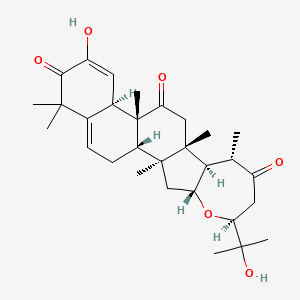| Authors | Title | Published | Journal | PubMed Link |
|---|---|---|---|---|
| Ayyad SE et al. | In vitro and in vivo study of cucurbitacins-type triterpene glucoside from Citrullus colocynthis growing in Saudi Arabia against hepatocellular carcinoma. | 2012 | Environ. Toxicol. Pharmacol. | pmid:22245841 |
| Chen X et al. | Biological activities and potential molecular targets of cucurbitacins: a focus on cancer. | 2012 | Anticancer Drugs | pmid:22561419 |
| Ren S et al. | Anti-proliferative effect of 23,24-dihydrocucurbitacin F on human prostate cancer cells through induction of actin aggregation and cofilin-actin rod formation. | 2012 | Cancer Chemother. Pharmacol. | pmid:22814677 |
| RÃos JL et al. | Cucurbitacins as inducers of cell death and a rich source of potential anticancer compounds. | 2012 | Curr. Pharm. Des. | pmid:22443631 |
| Abbas S et al. | The cucurbitacins E, D and I: investigation of their cytotoxicity toward human chondrosarcoma SW 1353 cell line and their biotransformation in man liver. | 2013 | Toxicol. Lett. | pmid:23194827 |
| Lang KL et al. | Chemical modification produces species-specific changes in cucurbitacin antifeedant effect. | 2013 | J. Agric. Food Chem. | pmid:23646892 |
| Zhang YT et al. | Formation of cofilin-actin rods following cucurbitacin-B-induced actin aggregation depends on Slingshot homolog 1-mediated cofilin hyperactivation. | 2013 | J. Cell. Biochem. | pmid:23695982 |
| Guo RH et al. | Synthesis of hemslecin A derivatives: a new class of hepatitis B virus inhibitors. | 2013 | Bioorg. Med. Chem. Lett. | pmid:23385212 |
| He J et al. | Cucurbitacin IIa induces caspase-3-dependent apoptosis and enhances autophagy in lipopolysaccharide-stimulated RAW 264.7 macrophages. | 2013 | Int. Immunopharmacol. | pmid:23541744 |
| Gabrielsen M et al. | Cucurbitacin covalent bonding to cysteine thiols: the filamentous-actin severing protein Cofilin1 as an exemplary target. | 2013 | Cell Commun. Signal | pmid:23945128 |
Cucurbitacin S
Cucurbitacin s is a lipid of Sterol Lipids (ST) class. The involved functions are known as establishment and maintenance of localization and nitric oxide biosynthetic process.
Cross Reference
Introduction
To understand associated biological information of Cucurbitacin S, we collected biological information of abnormalities, associated pathways, cellular/molecular locations, biological functions, related genes/proteins, lipids and common seen animal/experimental models with organized paragraphs from literatures.
What diseases are associated with Cucurbitacin S?
There are no associated biomedical information in the current reference collection.
No disease MeSH terms mapped to the current reference collection.
PubChem Associated disorders and diseases
What pathways are associated with Cucurbitacin S
There are no associated biomedical information in the current reference collection.
PubChem Biomolecular Interactions and Pathways
Link to PubChem Biomolecular Interactions and PathwaysWhat cellular locations are associated with Cucurbitacin S?
There are no associated biomedical information in the current reference collection.
What functions are associated with Cucurbitacin S?
Related references are published most in these journals:
| Function | Cross reference | Weighted score | Related literatures |
|---|
What lipids are associated with Cucurbitacin S?
There are no associated biomedical information in the current reference collection.
What genes are associated with Cucurbitacin S?
There are no associated biomedical information in the current reference collection.
What common seen animal models are associated with Cucurbitacin S?
There are no associated biomedical information in the current reference collection.
